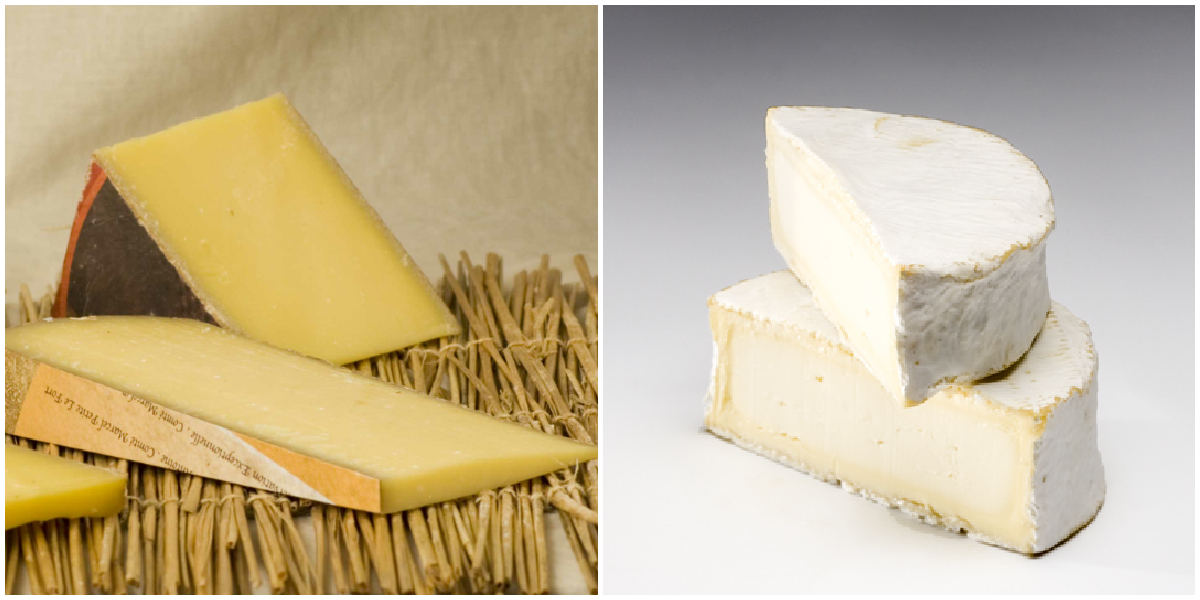5 French Cheeses You Need To Seek Out
We may receive a commission on purchases made from links.

The fruity alpine-style Marcel Petite Comté (left) and the triple-crème Brillat Savarin.
Martin Johnson knows a thing or two about good cheese. Since 1984, he has worked at and managed several of New York City's leading cheese counters, including Petak's, Bedford Cheese Shop and Bloomingdale's (believe it or not, Bloomingdale's had an impressive food section in the 1980s). In addition to having established the cheese programs for In Vino and Terroir Tribeca, he conducts cheese and beverage classes at the 92nd Street Y.
Johnson currently manages the extensive cheese and charcuterie section at Gastronomie 491, a specialty food market and eatery on the Upper West Side that carries around 70 cheeses at any given time. We caught up with the man recently featured in the New York Times for his humorous cheese signage to tell us the five essential French cheeses to know, and eat.
1. Roquefort Rodolphe Le Meunier
Once dubbed the "Zidane of fromagers," Rodolphe Le Meunier is one of the masters of aging cheese in France. "When most people think about blue cheeses, they envision a Mike Tyson knockout, haymaker punch to their palate," says Johnson. "But this is often the result of a lot of strong cheeses that are poorly handled, or lack attention to detail." Vastly different than most Roqueforts, the Le Meunier has all the qualities of a great blue: a butteriness and slight sweetness, which are characteristics of the sheep's milk, richer and more buttery than cow's milk. The result is flavors that announce themselves on the palate without overpowering it, and a wonderful cheese that is an ensemble player in a category of cheeses with high levels of flamboyance.
2. Camembert Jouvence
This Camembert is made from thermalized milk. While the common process of pasteurization creates a clear statistical reduction in E. coli and listeria bacteria, it "also kills off a lot of the enzymes that give cheese its density, personality and flavor," according to Johnson. Thermalization heats the milk at a lower temperature for a longer period of time, creating the same reduction in the bacteria but preserving these enzymes. As a result, the Camembert Jouvence has a lot of mushroomy and root-vegetable flavors in a well-articulated sequence, which is a revelation for those accustomed to eating pasteurized variations of the cheese.
3. Marcel Petite Comté
Often referred to as French Gruyère, Comté is a classic alpine cheese made in the Jura mountain range that spans the Franco-Swiss border. Alpine cheeses traditionally have a very announced nuttiness, and this dominant flavor of roasted nuts make them ideal to pair with red wines. The Marcel Petite Comté is nifty because there are a lot of overtones of fruit to the follow-through of the flavor. It is a delicate cheese amid a whole collection of alpine cheeses that are very forward. Marcel Petite's delicacy makes it perfect to pair with complicated red wines like Gamays and Burgundies.
4. Tome d'Aquitaine
This alpine-style firm cheese is made from goat's milk in the Bordeaux region. It is rinsed in Sauternes, a sweet white wine, which gives it a sticky, funky look. It is a lean, herbal cheese with a little nuttiness and a very specifically sweet finish. The cheese was aged by Jean d'Alos, known along with Le Meunier as one of the top five affineurs in France.
5. Brillat Savarin
"There are cheeses that I don't adore but that I know have a strong constituency," says Johnson, referring to this triple-crème found primarily in Normandy and named after 18th century French politician and epicure Jean Anthelme Brillat-Savarin, author of The Physiology of Taste. The cheese is an ideal companion for sparkling wine because its richness counters the bubbles. And talk about rich. The triple cream Brie's fat content is at least 75%.
Read more about French cheeses on Food Republic:

